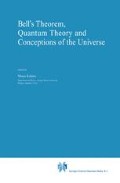Abstract
We argue that supraluminal correlation without supraluminal signaling is a necessary consequence of any finite and discrete model for physics. Every day, the commercial and military practice of using encrypted communication based on correlated, pseudo-random signals illustrates this possibility. All that is needed are two levels of computational complexity which preclude using a smaller system to detect departures from “randomness” in the larger system. Hence, the experimental realizations of the EPR—Bohm experiment leave open the question of whether the world of experience is “random” or pseudo-random. The latter possibility could be demonstrated experimentally if a complexity parameter related to the arm length and switching time in an Aspect-type realization of the EPR-Bohm experiment is sufficiently small compared to the number of reliable total counts which can be obtained in practice.
Work supported by the Department of Energy, contract DE-AC03-76SF00515.
Access this chapter
Tax calculation will be finalised at checkout
Purchases are for personal use only
Preview
Unable to display preview. Download preview PDF.
References
Noyes, H. P. and McGoveran, D. O. (1989) ‘An Essay on Discrete Foundations for Physics,’ Physics Essays 2, No. 1, and references therein.
The argument is given in detail by McGoveran, D. O. in ‘Foundations for a Discrete Physics,’ Sec. 4.1, pp. 80–81 and also pp. 95–96; and in ‘Discrete and Combinatorial Physics,’ in Noyes, H. P., (ed.), (1988) Proceedings of the 9th Annual International Meeting of the Alternative Natural Philosophy Association, ANPA West, Mill Valley, California, p. 102.
Goldrich et al. (1986) ‘How to Construct Random Functions,’ Journal of the Association for Computing Machinery, 33, 792–807.
Manthey, M. J. (1985) ‘Program Bell,’ (unpublished).
Clauser, J. F., Horne, M. A., Shimony, A. and Holt, R. A. (1969) Phys. Rev. Letters, 23, 880.
Leggett, A. J. (1986) in ‘Proc. ISQM 2,’ Namiki, M. et al., (eds.), Tokyo, pp. 287–297.
Author information
Authors and Affiliations
Editor information
Editors and Affiliations
Rights and permissions
Copyright information
© 1989 Springer Science+Business Media Dordrecht
About this chapter
Cite this chapter
McGoveran, D.O., Noyes, H.P., Manthey, M.J. (1989). On the Computer Simulation of the EPR—Bohm Experiment. In: Kafatos, M. (eds) Bell’s Theorem, Quantum Theory and Conceptions of the Universe. Fundamental Theories of Physics, vol 37. Springer, Dordrecht. https://doi.org/10.1007/978-94-017-0849-4_23
Download citation
DOI: https://doi.org/10.1007/978-94-017-0849-4_23
Publisher Name: Springer, Dordrecht
Print ISBN: 978-90-481-4058-9
Online ISBN: 978-94-017-0849-4
eBook Packages: Springer Book Archive

